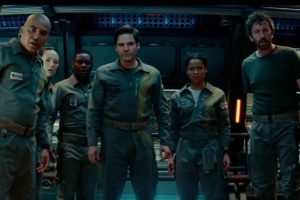 Review: Home Video
Review: Home Video
The Cloverfield Paradox | Julius Onah | US | 2018 | 102 minutes
Now streaming on Netflix»
Taylor Cherry reviews the latest installment in the Cloverfield franchise, which skipped theaters and appeared directly on Netflix.
The Cloverfield Paradox goes from boring as hell to unexpectedly exciting within the first half hour. A fan of the first two films in the series, Cloverfield (2008) and 10 Cloverfield Lane (2016) would not be totally disappointed.
I hoped that The Cloverfield Paradox went straight to streaming for reasons other than the usual reason films don’t go to theaters: They suck. I hoped that the film was just too weird for people, and that the studio, fearing it would not be profitable in theaters, instead believed it could become an instant cult classic on Netflix. Needless to say, I had high hopes.
These hopes were immediately crushed during the first five minutes of the film, as I was spoon-fed exposition about the world’s energy crisis. Ava (Gugu Mbatha-Raw) and her husband Michael (Roger Davies), converse in their car while in a long line waiting to get gas. The conversation extensively lays out the details of the energy crisis and her scientific mission to harness an endless supply of power. I don’t even enjoy this amount of detailed explanation when I’m stoned.
So within five minutes my hopes for this film were devastated, and while left with low expectations I just hoped that something, anything unexpected would happen.
And then that unexpected something happened: an odd and out-of-place montage during the title sequence, showing various attempts by the scientists to get an infinite power source. I had thought that this was what the entire movie was going to be about, and here it was alongside the opening credits.
At this point I had no idea what was going to happen, and that gave me hope. It reminded me of the first Cloverfield film where in the beginning you think the film is going to be about some party and the relationship between some guy and girl, and then BAM! A giant creature starts knocking down buildings.
The film picks up in pace and excitement. We are introduced to a cast of characters played by many impressive actors. Stranded on a research space vessel, Coverfield Station, are Kiel (David Oyelowo), Schmidt (Daniel Bruhl), Monk (John Ortiz), Mundy (Chris O’Dowd), Volkov (Aksel Hennie), and Tam (Ziyi Zhang).
After the events summarized in the opening montage, the scientists only have three more attempts to get the Shepard particle accelerator to generate an endless source of energy. In their next attempt, all looks good and they get excited. But THEN, something goes terribly wrong! They can’t find earth. Their navigation system is gone, and to make things worse, they find a woman in the wall. They soon realize they have traveled into a parallel universe. Woah! How unexpected! (I realize now that this was part of the synopsis, so perhaps not that unexpected).
After this moment, I started to really enjoy what I was watching. I had no idea what was going to happen, much like how I felt during the first two. One guy has worms coming out of him. Chris O’Dowd’s severed arm helps them find their navigation system. Unexpected obstacles cast doubt on who is to be trusted and what everyone’s fate will be. And these scenes are cross-cut with action down on earth that is facing a separate, but perhaps linked, devastation: the destruction by a giant creature.
I really enjoyed the first two Cloverfield films. On the surface, Cloverfield (2008) was a Godzilla rip-off with a cheesy romance story stuffed into it, but the first person perspective, inserted with well-staged gore, made the film suspenseful and thoroughly enjoyable. Though entirely different, 10 Cloverfield Lane (2016), was thrilling every moment and the end was a unexpected treat.
Not to give too much away, but it isn’t until the end of The Cloverfield Paradox that you see a glimpse of what connects at least the first and third films. The end-of-the-world feel connects all three, but not much else. All films seem to take place in different locations in different years, so I am curious to see if future films will make their connection clear. Knowing the fourth film is a World War 2 flick throws any of my guesses out the window. That won’t keep me from watching.